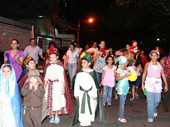Christmas and New Year Traditions in Panama

From late November, Panamanians begin to feel Christmas in the atmosphere, as stores and malls put out their decorations: giant Christmas trees and beautiful nativity scenes. Throughout the year hundreds of Panamanians have saved up so that they can afford the end of year celebrations. In early December the banks are full with people withdrawing their Christmas savings and shopping centers are full of people buying all kind of items for the December holidays: Mother’s Day (Dec 8), Christmas and New Year. Panamanians love to decorate and paint their houses for these celebrations. Starting on the 16th of December and finishing on the 24th, Panamanian communities across Panama hold what is known as "posada". To celebrate the birth of Jesus, families set up a makeshift ‘inns’ built with palm leaves, and the family will act as innkeepers. In communities children are chosen to represent Joseph and Mary in a pilgrimage looking for lodging, for the event of Jesus’s birth. Every night the children leave the community church toward a posada followed by a procession. Candies are given away to the attendees. On Christmas Eve, the last day of the posada, all the "inns" in the community are visited.
During Christmas and New Year Eve, the Albrook bus terminal in Panama City is packed with passengers travelling to celebrate the holidays with families across the bridge.
Family gatherings and meals at Christmas and New Year in Panama are very similar. Relatives gather in homes to prepare dinner: turkey or ham, rice with guandu (a nutritious green bean) and tamales. Apples, pears, grapes and nuts are always on the holiday table, as are the traditional rosca de huevo (A ring shaped egg bread) and rum punch. The whole family gathers to wait for twelve at night. The sound of fireworks announces that the expected time has arrived. Then, family members embrace each other and then enjoy the dinner they have prepared. After dinner, there are late night visits to neighbors houses. Those, who have friends or relatives far away, try to reach them by phone, congesting cell lines. The more adventurous ones, head to the clubs to finish the night and take advantage of the suspension of Zanahoria law, which says bars have to close at 3:00 am.
At Christmas children eagerly look forward to the moment of opening their gifts. In my childhood, my parents sent us to bed before 12 o'clock at night on the 24th. When we woke up the next morning we found our gifts on our beds, fully convinced that Santa Claus had brought them. Nowadays, gifts are placed under the Christmas tree on the 24th, and children wait anxiously to unwrap them at midnight.
For the New Year, Panamanians have a lot of traditions and rituals: Walking with a suitcase around the house will ensure a new year full of travels; eating twelve grapes at midnight and asking for 12 wishes; wearing yellow underwear to bring good luck; putting rice in a pot for wealth; using a red garment will attract love in the new year; having money in your hands at midnight will help you always have money during the coming year; a deep cleaning of the house with esoteric products (commonly found in grocery stores), and burning of incense on December 31 will get rid of bad energy; hanging a bunch of oranges, rice and wheat behind the door will bring prosperity, work and health at home; swimming in the ocean on January 1 will "clean out" the bad things of the previous year and bring in good things of the new year. Some families make Old Year Dolls or Judas Dolls with fireworks inside, these dolls are burned at midnight to destroy the unhappiness and negative energy of the dying old year.
Festivities culminates on January 6, Three Kings Day, many Panamanians go to the beaches with their Christmas tree to set them on fire and close out the most anticipated festivities for Panamanians.
